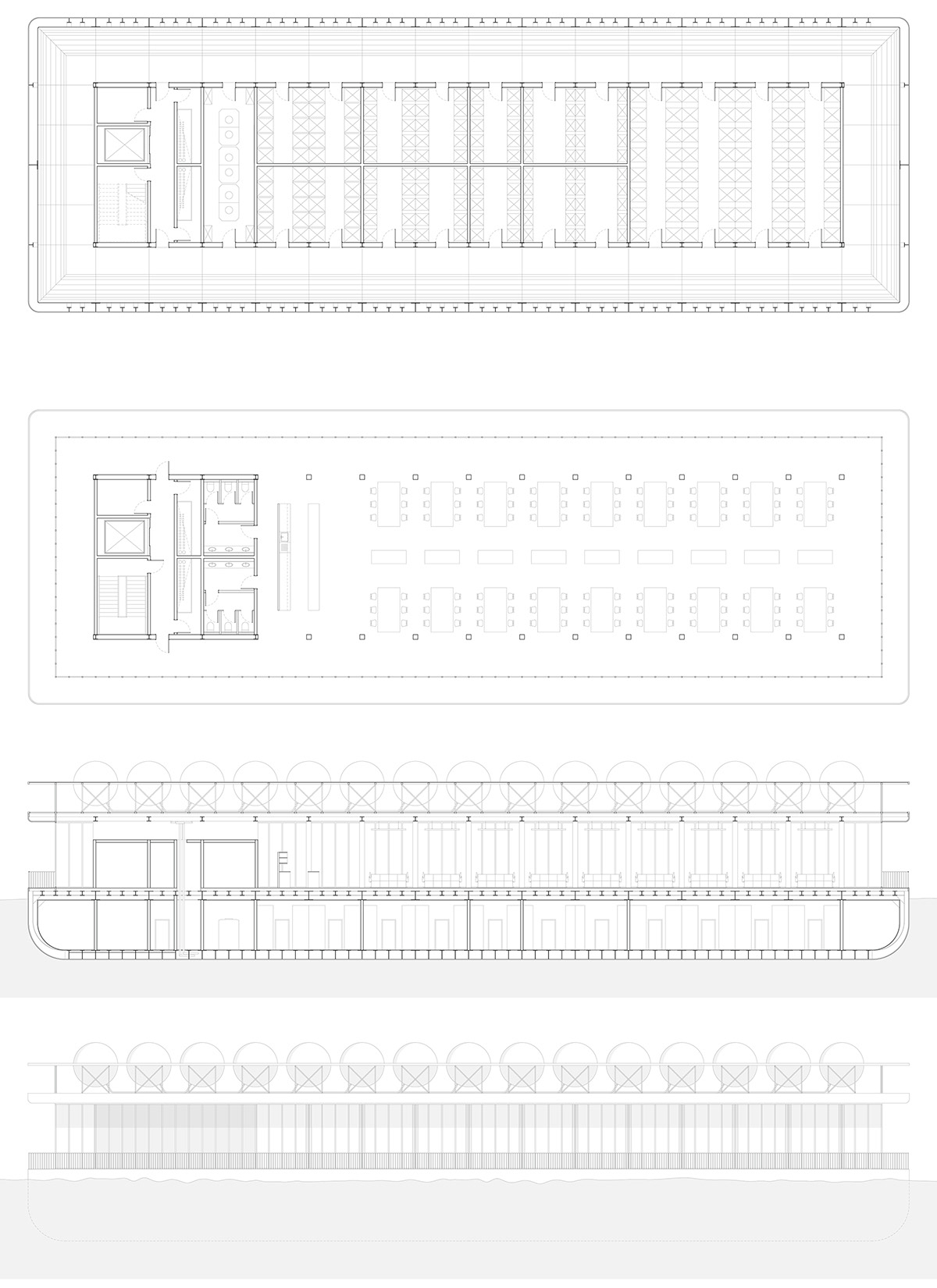
Approximately two-thirds of the Earth's surface is covered by water, a proportion that could potentially increase in the future due to global warming. Various approaches are currently being pursued worldwide to develop data centers that can adapt to water. In Germany, many cities are located in close proximity to water bodies, providing an excellent opportunity to utilize these as incubators for data.
The Data Boat was developed as part of the master's program at the Chair of Building Technology at RWTH Aachen University. As an autonomous inland data center, it cools the server racks by utilizing the low water temperature, thus featuring low energy consumption. Thanks to its flexible positioning in the water, it not only ensures minimal latency but also enables versatile use of the deck.
The Data Boat was developed as part of the master's program at the Chair of Building Technology at RWTH Aachen University. As an autonomous inland data center, it cools the server racks by utilizing the low water temperature, thus featuring low energy consumption. Thanks to its flexible positioning in the water, it not only ensures minimal latency but also enables versatile use of the deck.





Perspective from Rhine bank
The proposed location is in the Rhine River, near the TH Köln campus. Under these conditions, the data center could not only serve the needs of the university, but its deck could also function as a mixed-use area for student activities. The Data Boat is equipped with approximately 64 racks, each possessing a 100% redundant infrastructure. This infrastructure is powered by a diverse energy concept, creating an adaptive data center capable of supporting various locations. The operational energy is generated by the hydrogen fuel cells located in the hull. In summer, river water is utilized as part of the condenser loop for the adsorption chiller, while in winter, it is used for the cooler loop. Additionally, in winter, the platform is heated by the heat generated from the racks and the fuel cells.

Plans and sections
The data racks are ensured with 100% redundancy infrastructure. Using hydrogen as the main source of power guaranties no production of carbon monoxide. In cold weather the platform will be heated by the recovered heat from the racks and the fuel cells, moreover, the river water is used as a part of the cooling circuit. This diverse energy concept contributes to an adaptive data center that meets high environment friendly standards.
The Structure of the boat is based on the principles of the transverse frame system. Whereby the bracings, are arranged in the transverse direction. The bottom of the boat has a doubled structure. This provides increased safety in case of damage also helps to stay buoyant in case of leakage. A part of the longitudinal and transverse bracings is water- and oil-tight in order to use it for storage. Ballast water tanks can be also used to correct the ship's buoyancy and increase stability. Analogous to this function, the interstitial space in the double bottom of the data boat is also used as tanks for the heat exchangers of the cooling system.
The Structure of the boat is based on the principles of the transverse frame system. Whereby the bracings, are arranged in the transverse direction. The bottom of the boat has a doubled structure. This provides increased safety in case of damage also helps to stay buoyant in case of leakage. A part of the longitudinal and transverse bracings is water- and oil-tight in order to use it for storage. Ballast water tanks can be also used to correct the ship's buoyancy and increase stability. Analogous to this function, the interstitial space in the double bottom of the data boat is also used as tanks for the heat exchangers of the cooling system.

Facade cutout
The construction elements of the boat follow the transverse frame system, with the stiffening frames arranged transversely. This construction method is applied to smaller ships with a length of less than 60 meters. To accommodate the decreasing water pressure from bottom to top, the cross-sections of the frames vary, being stronger towards the bottom. For safety reasons, the hydrogen tanks are planned above the deck. This facilitates tank filling and minimizes potential damage in case of a leak. The frame ribs are positioned in the boat's support system to absorb specific loads at the locations of the deck supports, which carry both the roof and the hydrogen storage. The hull's floor is designed as a double bottom, enhancing safety in the event of damage to the ship's bottom. The space within the double bottom is specifically allocated for water tanks. These tanks function as ballast water tanks, enabling adjustment of the ship's buoyancy. Additionally, the tanks serve as heat exchangers in the cooling circuit of the data center, thanks to their substantial contact surface with the water. Pipe channels in the double bottom are arranged to accommodate the pipes and fittings required for filling and emptying the double bottom tanks.

1-steel frame, 2-secondary beam, 3-main beam, 4-deck support, 5-space beam, 6-joist, 7-frame rib, 8-space bulkhead, 9-joist, 10-longitudinal beam, 11-floor plates, 12-center longitudinal beam, 13-data and power installation, 14-hydrogen installation, 15-cooling installation, 16-heat exchanger installation, 17-cooling pipes, 18-full floor plates, 19-heat exchanger pipes, , 20-tight floor plates, 21-tank ceiling, 22-expanded metal, 23-hydrogen tanks. 24- roof frame with thermally insulated glazing, 25-facade frame with thermally insulated glazing, 26-hull plating.

Perspective for the platform


